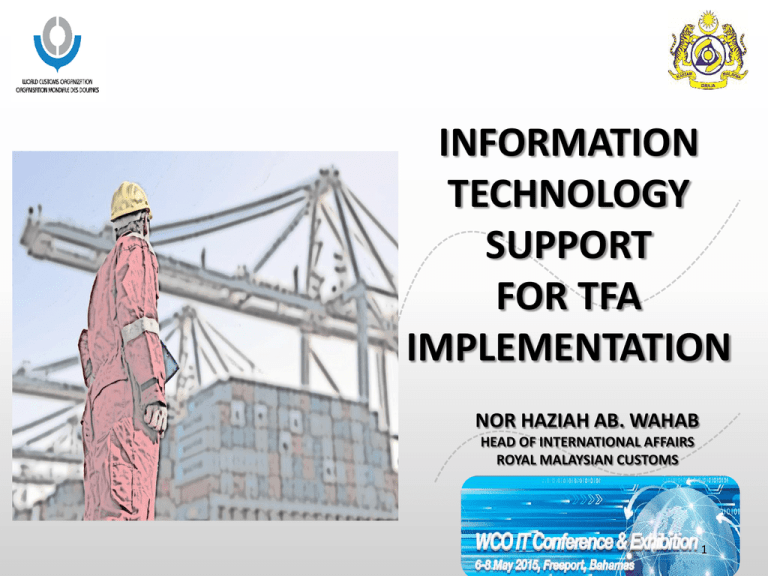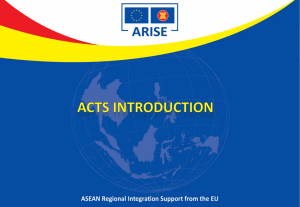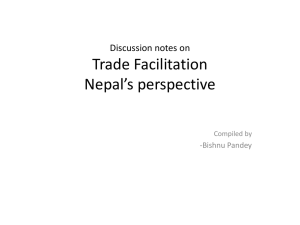Ms. Nor Haziah Abd Wahab
advertisement

INFORMATION TECHNOLOGY SUPPORT FOR TFA IMPLEMENTATION NOR HAZIAH AB. WAHAB HEAD OF INTERNATIONAL AFFAIRS ROYAL MALAYSIAN CUSTOMS 1 OUTLINE I. Overview of Malaysia and WTO II. Overview of WTO Agreement On Trade Facilitation III. Overview of ASEAN Economic Community and ASEAN Trade Facilitation Measures IV. Article 10: Formalities Connected With Importation And Exportation and Transit V. ASEAN Cargo Transit System VI. Conclusion 2 OVERVIEW – Malaysia & WTO Member in GATT since 1957 participated in Tokyo & Uruguay Round; One of the Founding member of WTO , established on 1 January 1995; The WTO Agreement On Trade Facilitation Deals Almost Entirely With Customs-related Topics But Includes Cooperation With Other Agencies MITI is focal point for General WTO-related works. 3 Cabinet Approval Granted In Early July 2014 Notify WTO On 23rd July 2014 23 July 2014 Preparatory Committee on Trade Facilitation NOTIFICATION OF CATEGORY A COMMITMENTS UNDER THE AGREEMENT ON TRADE FACILITATION Original: English COMMUNICATION FROM MALAYSIA The following communication dated 22 July 2014 to the Preparatory Committee on Trade Facilitation is being circulated on behalf of Malaysia for Members' information. _____________________________ Pursuant to the Ministerial Decision of 7 December 2013 (WT/MIN(13)/36, WT/L/911), the Preparatory Committee on Trade Facilitation established under the General Council (hereinafter referred to as the "Preparatory Committee") shall, inter alia, receive Members' notifications of Category A commitments under the Agreement on Trade Facilitation (hereinafter referred to as the "Agreement"). With reference to the above, the Government of Malaysia has the honour to notify the Preparatory Committee that Malaysia hereby designates all provisions contained in Articles 1 to 12 of the Agreement (annexed to the above Ministerial Decision) under Category A, except for the following: Article 7.8 (Expedited Shipments); and Article 11.9 (Advance filing and processing of transit documentation and 4 OVERVIEW ON WTO AGREEMENT ON TRADE FACILITATION AGREEMENT The World Trade Organization Agreement on Trade Facilitation (ATF) was adopted at the WTO’s Ninth Ministerial Conference held in Bali, Indonesia, in December 2013. The ICT component is a crucial factor on implementation of ATF . A number of provision in the WTO ATF specifically mention the use of ICT and its role in the ATF implementation 5 OVERVIEW ON WTO AGREEMENT ON TRADE FACILITATION AGREEMENT ARTICLE 1: PUBLICATION AND AVAILABILITY OF INFORMATION Focus on the types of information that governments need to provide to the public regarding import, export and transit procedure and the manner by which it is provided via the internet. ARTICLE 7: RELEASE AND CLEARANCE OF GOODS Dependent on ICT and includes areas on pre-arrival processing, electronic payment, risk management, post-clearance audit, publication of average release time, expedited shipments and perishable goods. Single Window environment at national / Regional level ARTICLE 10: FORMALITIES CONNECTED WITH IMPORTATION AND EXPORTATION AND TRANSIT The measures listed in this Article provide for an automated environment for the processing of cargo at borders. ASEAN ECONOMIC COMMUNITY The AEC Blueprint Outlines economic integration measures to be implemented. Has 4 key characteristics: (i) single market; (ii) a highly competitive economic region; (iii) a region of equitable economic development; and (iv) a region fully integrated into the global economy Examples of ASEAN Trade Facilitation Measures ASEAN Harmonized Tariff Nomenclature ASEAN Customs Transit System ASEAN Self-Certification ASEAN Single Window 7 COMPARISON OF WTO TF AGREEMENT AND ASEAN TF MEASURES WTO TF Agreement ASEAN TF Measures Article 10.4: Single • Agreement to Establish and Window Implement the ASEAN Single Window (ASW) • Protocol to Establish and Implement the ASW Article 11: Freedom • ASEAN Framework Agreement on of Transit the Facilitation of Goods in Transit (AFAFGIT) Article 12: Customs • Article 85 (Co-operation) of ATIGA Cooperation • Articles 43 (Areas of Cooperation) and 44 (Mechanisms for Cooperation) of AAC 8 ASEAN CUSTOMS TRANSIT SYSTEM Based on 5 key elements: 1. Fully computerised: electronic messages used for (i) communications between traders and Customs for the lodgement of transit declarations and the discharge of completed transit movements; and (ii) the exchange of transit movement data between customs authorities 2. System open to all “authorised " traders. 3. Risk profiling scheme: To allow reliable traders "simplifications” or exemptions from a range of standard requirements 4. One guarantee valid in all countries to cover the goods throughout the entire journey 5. Single regional customs document for transit 9 ASEAN CARGO TRANSIT SYSTEM The proposal for Transit include • Acceptance that Customs controls carried out in one country are accepted by any other • Pilot system in Thailand, Malaysia and Singapore • Legal requirement provided under AFAFGIT • Full end to end computerization of operations 10 PILOT PROJECT 11 ASEAN CARGO TRANSIT SYSTEM A secure and efficient system through: • A complete Customs to Customs network • A complete Customs to Business network Allows Free movement for trucks and drivers Computerization provides: • Immediate acquittal of individual movements • Full monitoring and fast acquittal of Guarantee 12 CONCLUSION Strong commitments Striking a balance between “flexibilities in implementation” of transit procedures and achieving uniformity Role of technical assistance beyond capacity building Actual implementation – proper follow through from regional commitments to national level implementation Take into account different state of readiness of AMS – pilot project approach, differentiated timeline, etc Need strong institutional capacity (ASEAN Secretariat) to support implementation of TF measures 13 TERIMA KASIH THANK YOU ROYAL MALAYSIAN CUSTOMS HEADQUARTERS, PUTRAJAYA






